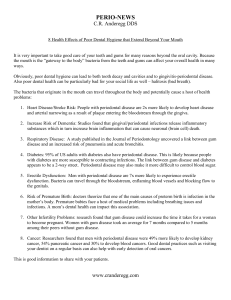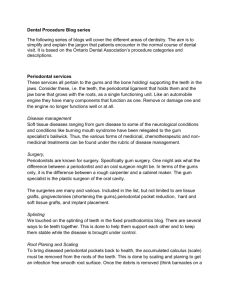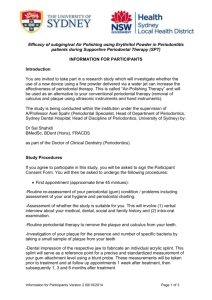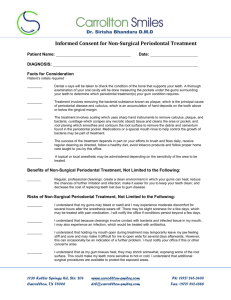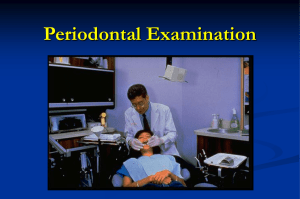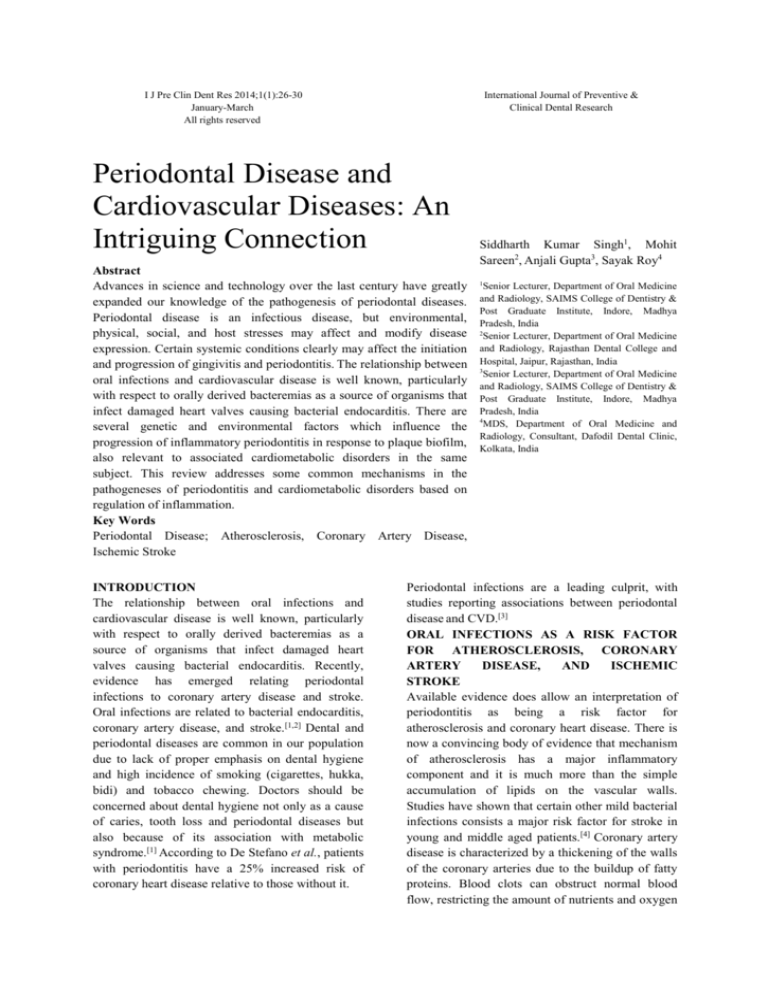
I J Pre Clin Dent Res 2014;1(1):26-30
January-March
All rights reserved
International Journal of Preventive &
Clinical Dental Research
Periodontal Disease and
Cardiovascular Diseases: An
Intriguing Connection
Abstract
Advances in science and technology over the last century have greatly
expanded our knowledge of the pathogenesis of periodontal diseases.
Periodontal disease is an infectious disease, but environmental,
physical, social, and host stresses may affect and modify disease
expression. Certain systemic conditions clearly may affect the initiation
and progression of gingivitis and periodontitis. The relationship between
oral infections and cardiovascular disease is well known, particularly
with respect to orally derived bacteremias as a source of organisms that
infect damaged heart valves causing bacterial endocarditis. There are
several genetic and environmental factors which influence the
progression of inflammatory periodontitis in response to plaque biofilm,
also relevant to associated cardiometabolic disorders in the same
subject. This review addresses some common mechanisms in the
pathogeneses of periodontitis and cardiometabolic disorders based on
regulation of inflammation.
Key Words
Periodontal Disease; Atherosclerosis, Coronary Artery Disease,
Ischemic Stroke
INTRODUCTION
The relationship between oral infections and
cardiovascular disease is well known, particularly
with respect to orally derived bacteremias as a
source of organisms that infect damaged heart
valves causing bacterial endocarditis. Recently,
evidence has emerged relating periodontal
infections to coronary artery disease and stroke.
Oral infections are related to bacterial endocarditis,
coronary artery disease, and stroke.[1,2] Dental and
periodontal diseases are common in our population
due to lack of proper emphasis on dental hygiene
and high incidence of smoking (cigarettes, hukka,
bidi) and tobacco chewing. Doctors should be
concerned about dental hygiene not only as a cause
of caries, tooth loss and periodontal diseases but
also because of its association with metabolic
syndrome.[1] According to De Stefano et al., patients
with periodontitis have a 25% increased risk of
coronary heart disease relative to those without it.
Siddharth Kumar Singh1, Mohit
Sareen2, Anjali Gupta3, Sayak Roy4
1
Senior Lecturer, Department of Oral Medicine
and Radiology, SAIMS College of Dentistry &
Post Graduate Institute, Indore, Madhya
Pradesh, India
2
Senior Lecturer, Department of Oral Medicine
and Radiology, Rajasthan Dental College and
Hospital, Jaipur, Rajasthan, India
3
Senior Lecturer, Department of Oral Medicine
and Radiology, SAIMS College of Dentistry &
Post Graduate Institute, Indore, Madhya
Pradesh, India
4
MDS, Department of Oral Medicine and
Radiology, Consultant, Dafodil Dental Clinic,
Kolkata, India
Periodontal infections are a leading culprit, with
studies reporting associations between periodontal
disease and CVD.[3]
ORAL INFECTIONS AS A RISK FACTOR
FOR ATHEROSCLEROSIS, CORONARY
ARTERY
DISEASE,
AND
ISCHEMIC
STROKE
Available evidence does allow an interpretation of
periodontitis as being a risk factor for
atherosclerosis and coronary heart disease. There is
now a convincing body of evidence that mechanism
of atherosclerosis has a major inflammatory
component and it is much more than the simple
accumulation of lipids on the vascular walls.
Studies have shown that certain other mild bacterial
infections consists a major risk factor for stroke in
young and middle aged patients.[4] Coronary artery
disease is characterized by a thickening of the walls
of the coronary arteries due to the buildup of fatty
proteins. Blood clots can obstruct normal blood
flow, restricting the amount of nutrients and oxygen
27
Periodontal Disease and Cardiovascular Diseases
required for the heart to function properly. This may
lead to heart attacks. Another possibility is that the
inflammation caused by periodontal disease
increases plaque buildup, which may contribute to
swelling of the arteries. The association between
periodontitis and CVD may be because of common
risk factors such as smoking, diabetes mellitus,
aging, male gender and socioeconomic factors, but
there is also good evidence of periodontitis being an
independent risk factor of CVD.[5] The role of
infections in atherosclerosis has been discussed for
many years. Recently, evidence has accumulated
that certain common oral infections play a
significant in role in atherosclerosis. Atherosclerosis
lesions can occur in large and medium sized elastic
and muscular arteries.[6] They can lead to ischemic
lesions of the brain, heart, or extremities and can
result in thrombosis and infarction of affected
vessels, leading to death. Cardiovascular disease,
mostly associated with atherosclerosis, remains one
of the primary causes of death in the United States,
Europe, and much of Asia. The process, supported
by a considerable body of evidence, is that
atherosclerosis is an inflammatory disease. This
concept, also termed the Ross response-to-injury
hypothesis of atherosclerosis which proposes that
the initial lesion results from injury to the
endothelium and leads to a chronic inflammatory
process in the artery. This results in the migration of
monocytes through the endothelium into the
underlying tissue and the proliferation of smooth
muscle cells. Activation of the monocytes
(macrophages) in the blood vessel leads to the
release of hydrolytic enzymes, cytokines,
chemokines, and growth factors, which induces
further damage, leading to focal necrosis.
Accumulation of lipids is a key feature of this
process, and in later stages, the atheromatous plaque
can be covered with a fibrous cap over the focal
necrotic area. At some point, the fibrous cap may
become eroded and rupture, which leads to
thrombus formation and occlusion of the artery,
resulting in an infarction.[7] The initial event in the
development of an atheroma appears to be
endothelial injury that results in the activation of the
endothelial cells. This results in the upregulation of
surface adhesin molecules and chemokines, both of
which result in monocyte recruitment from the
bloodstream (Fig. 1). The monocytes then pass
through the endothelium into the blood vessel and
become macrophages. The macrophages in the
atheroma are activated and produce growth factors,
Singh SK, Sareen M, Gupta A, Roy S
which induce smooth muscle proliferation as well as
production of cytokines and other mediators that
further activate the endothelium. Macrophages also
accumulate
lipids,
especially
low-density
lipoproteins (LDL) in the oxidized or modified
form. Modified LDL can be a major cause of injury
of both the endothelium and the underlying smooth
muscle. When the LDL particles are trapped in the
artery, they can undergo progressive oxidation and
be internalized by macrophages, with formation of
lipid peroxidases and accumulation of cholesterol
esters. This results in the production of foam cells.
Modified LDL is chemotactic for other monocytes
and can induce the production of factors from
macrophages that expand the inflammatory
response.[8,9] Antioxidants can increase the
resistance of LDL to oxidation, and this may
explain why antioxidants, such as vitamin E, can
reduce the size of fatty streaks and atherosclerotic
lesions and possibly protect against atheroma
formation. Diabetes, through hyperglycemia and
glycation of LDL and other proteins, as well as the
dyslipidemia associated with diabetes, cigarette
smoking, through toxic factors in smoke, and
hypertension and hyperhomocystinemia are also
factors that can lead to endothelial injury and the
subsequent cascade of events leading to
atherosclerotic lesions.[10]
Fig. 1: Mechanism of atherosclerosis resulting
from endothelial injury
A fatty streak can become a fibrous plaque, which
becomes complex with a lipid core, calcification,
and deposition of extracellular matrix protein.
Activated T cells may stimulate metalloproteinase
production by macrophages, which remodel the
fibrotic plaque. Eventually, a uniformly dense
fibrous cap can cover the atheroma resulting from
deposition and remodeling of the extracellular
matrix in the plaque. Through remodeling of the
extracellular matrix, the fibrous cap may become
thin and rupture, leading to activation of the clotting
system with thrombosis. It is thought that
thrombosis and subsequent occlusion of the artery
may be responsible for as many as one-half of the
28
Periodontal Disease and Cardiovascular Diseases
cases of acute myocardial infarction.[11] Fig. 2
depicts the intersecting protease cascade that
connects the blood clotting system with
extracellular matrix deposition and degradation. The
extracellular matrix is produced by smooth muscle
cells and endothelium and remodeled through
degradation with endopeptidases, the matrix
metalloproteinases. From Fig. 2 it can be seen that
plasminogen is converted to plasmin in the presence
of tissue plasmin activator (TPA).
Fig. 2: Intersecting protease cascade that
connects the blood clotting system with
extracellular
deposition
degradation
Plasmin then matrix
activates
the and
latent
matrix
metalloproteinases, which results in matrix
degradation.
Tissue
inhibitors
of
matrix
metalloproteinases (TIMPs) can inhibit matrix
degradation whereas alpha-1-antitrypsin can inhibit
plasmin mediated degradation of the extracellular
matrix. Plasmin can also result in the production of
fibrin from fibrinogen, which then undergoes
fibrinolysis. It is likely that inflammatory mediators,
such as cytokines and proteases produced by
macrophages, and other cells in the atheromatous
plaque, as well as bacterial proteases,
contribute to extracellular matrix remodeling of
fibrofatty atheromatous plaques through activation
at various stages in the protease cascade depicted in
Fig. 2.
DIRECT
EFFECTS
OF
INFECTIOUS
AGENTS IN ATHEROMA FORMATION
There are three lines of evidence suggesting that
periodontal bacteria may have direct effects on
atheroma formation. The first comes from studies
finding Porpbyromonus gingivulis in carotid and
coronary heromas. The second comes from the
findings of Deshpande and colleagues showing in
vitro that P gingivulis invade and may proliferate in
the endothelial cells. The third line of evidence
comes from studies by Herzberg and Meyer
showing that P gingivulis is able to induce
aggregation of platelets, which is thought to be
associated with thrombus formation. Other possible
mechanisms include protease production by P
gingivulis and other periodontal pathogens, which
Singh SK, Sareen M, Gupta A, Roy S
may contribute to remodeling of the extracellular
matrix in atheromatous plaques. Evidence for any of
these mechanisms is, at this point, in vitro or
preliminary. However, it is not unreasonable to
expect that organisms that infect atheromatous
plaques may contribute to their formation or to the
thrombotic events associated with myocardial
infarction.[14]
INDIRECT OR HOST-MEDIATED EFFECTS
TRIGGERED BY INFECTION
One possible mechanism that has garnered
considerable support is that periodontitis induces an
inflammatory response that is manifested, in part,
by the production of acute-phase proteins, such as
C-reactive protein and fibrinogen, by the liver. Creactive protein and fibrinogen are independent risk
factors for coronary artery disease. A recent study
by Wu and colleagues using the NHANES III
database, found that C-reactive protein and plasma
fibrinogen were related to poor periodontal health,
which provides support for this hypothesis. Another
indirect effect of periodontal infection that may
explain the association between periodontal disease
and heart disease is that periodontal organisms
contain proteins which cross-react with the heart. In
fact, the heat-shock protein-60, which is produced
by Bucteroidesforytbus and P gingivulis, has about
60% homology with the mammalian heat-shock
protein. It is known that antibodies to the heat-shock
protein are found in patients with periodontal
disease. It is conceivable then that these antibodies
to heat-shock proteins of periodontal bacteria are
cross-reactive with the heat-shock protein that is
exposed in an injured endothelium or atheromatous
plaque. This could set in motion autoimmune
phenomena and contribute to atheroma formation.[1]
COMMON GENETIC PREDISPOSITION FOR
PERIODONTAL
DISEASE
AND
ATHEROSCLEROSIS
There may be common genetic mechanisms which
provide the link between periodontal disease and
cardiovascular disease. Beck and colleagues have
provided a model proposing that there is a
genetically
determined
hyperinflammatory
macrophage phenotype in periodontal disease,
which contributes to the susceptibility for
atherosclerosis.[15]
COMMON RISK FACTORS AFFECTING
BOTH PERIODONTAL DISEASE AND
HEART DISEASE
DeStefano and colleagues found that periodontal
disease and poor oral hygiene are stronger
29
Periodontal Disease and Cardiovascular Diseases
indicators of risk of total mortality and of coronary
heart disease. They suggest that oral hygiene may
be an indicator or a surrogate for lifestyle affecting
personal hygiene and health care and might explain
the relationship between periodontal disease and
heart disease. Multiple studies showing the
relationship between periodontal disease and heart
disease, after adjusting for many factors associated
with lifestyle, such as smoking and overweight,
suggest that the relationship is not simply explained
by lifestyle. Also, the finding that the graded
exposure of periodontal disease leads to an
increased cumulative index of coronary heart
disease argues against lifestyle as a simple
explanation for this association. The association
between periodontal disease and cardiovascular
disease or stroke could be due to residual
confounders or incomplete control of confounders.
As with most studies that adjust for possible
confounders, the adjustments may not be complete,
so associations of this magnitude may be due to
residual confounders. Perhaps new studies with
more detailed adjustments for confounders will
clarify this issue. In fact, there are two studies in
progress, supported by the National Institutes of
Health (NIH), which may help resolve this issue.
Further research will be needed to determine which,
and to what extent, factors act singly or in concert to
contribute to the formation of atheromatous plaques.
It is important to know the mechanisms, however,
since they add evidence to support the association
between periodontal infection and atherosclerosis.
In addition, knowing the mechanisms may well lead
to simple, cost-effective interventions that would
moderate, in part, the contribution of infection to
atherosclerosis.[1]
MANAGEMENT
OF
PERIODONTAL
DISEASE IN PATIENTS AT HIGH RISK FOR
ATHEROSCLEROSIS [16-19]
Since there is mounting evidence relating
periodontal infections to atherosclerosis, it is
reasonable that patients with periodontal disease
who are at risk for atherosclerotic disease should be
managed in the following manner:
1. Patients at high risk for atherosclerotic disease
should be subjected to a complete periodontal
examination.
2. Patients that have periodontal disease should
have a thorough medical history evaluating
systemic conditions, medications, and risk
factors for atherosclerosis and related
conditions such as heart disease and stroke.
Singh SK, Sareen M, Gupta A, Roy S
3.
Treatment of patients with periodontal disease
and pre-existing atherosclerotic disease, such
as stroke, nonfatal myocardial infarction, and
atherosclerosis in general, should be
coordinated among health professionals to
ensure that patients are adequately managed
taking into account medical as well as dental
considerations and complications.
4. Aggressive prevention of periodontal disease
should be undertaken in patients at high risk
for atherosclerotic disease. If periodontal
disease exists in these high-risk patients,
comprehensive treatment should be instituted
to eradicate, as much as possible, the
periodontal infection and prevent its
recurrence.
5. Patients should be made completely aware of
the possible relationship between heart
disease, stroke, and periodontal disease,
without unduly alarming them, so that they
may participate in the modification of risk
factors for both artherosclerosis and
periodontal disease.
REFERENCES
1. Rose, Genco, Mealey, Cohen: Periodontal
Medicine, B.C. Decker Inc, 2000.
2. Soory M. Chronic Periodontitis As A Risk
Marker For Systemic Diseases With Reference
To Cardiometabolic Disorders: Common
Pathways In Their Progression. Immunology
And Immunogenetics Insights. 2010;2:7-21.
3. Demmer RT, Desvarieux M. Periodontal
Infections And Cardiovascular Disease.
JADA. 2009;137(2):14-20.
4. Karnoustos K, Papastergiou P. Periodontitis
As A Risk Factor For Cardiovascular Disease.
Ann Periodontal. 1998;3(1):127-141.
5. Offenbacher S. Systemic effects of
periodontitis: epidemiology of periodontal
disease and cardiovascular disease. J
Periodontol. 2005;76(11 Suppl):2089-2100.
6. Beck J, Garcia R, Heiss G, Vokonas PS,
Offenbacher S. Periodontal disease and
cardiovascular
disease.
J
Periodontol.
1996;67(supplement 10):1123-37.
7. Grau AJ, Becher H, Ziegler CM. Periodontal
disease as a risk factor for ischemic stroke.
Stroke. 2004;35(2):496-501.
8. Beck JD, Pankow J, Tyroler HA, Offenbacher
S. Dental infections and atherosclerosis. Am
Heart J. 1999;138(5 part 2):S528-33.
30
9.
10.
11.
12.
13.
14.
15.
16.
17.
18.
19.
Periodontal Disease and Cardiovascular Diseases
Herzberg MC, Meyer MW. Effects of oral
flora on platelets: possible consequences in
cardiovascular
disease.
J
Periodontol.
1996;67(supplement 10):1138-42.
Mattila KJ, Nieminen MS, Valtonen VV.
Association between dental health and acute
myocardial infarction. BMJ. 1989;298(6676):
779-81.
Janket SJ, Baird AE, Chuang SK, Jones JA.
Meta-analysis of periodontal disease and risk
of coronary heart disease and stroke. Oral Surg
Oral Med Oral Pathol Oral Radiol Endod.
2003;95(5):559-69.
Is There a Link Between Periodontitis And
Cardiovascular Disease? Supplement To
RCDSO Dispatch Summer 2005.
Saini R, Saini S. Periodontal Disease: A Risk
Factor To Cardiovascular Disease. Ann Card
Anaesth. 2010;13:159-61.
Pussinen PJ, Alfthan G, Rissanen H, Reunanen
A, Asikainen S, Knekt P. Antibodies to
periodontal pathogens and stroke risk. Stroke.
2004;35(9):2020-30.
Li X, Kolltveit KM, Tronstad L, Olsen I.
Systemic diseases caused by oral infection.
Clin Microbiol Rev. 2000;13(4):547-58.
Greenwood M. Medical emergencies in the
dental practice. Periodontol 2000. 2008;46:2741.
Silvestre-Donat FJ. Dental management of
ischaemic heart disease. Medicina Oral.
2003;8:230.
Becker DE. Preoperative Medical Evaluation:
Part 1: General Principles and Cardiovascular
Considerations. Anesth Prog. 2009;56:92-103.
Wilson W, Taubert KA, gewitz M, lockhart
PB, Baddour lM, levison M, et al. Prevention
of infective endocarditis: guidelines from the
American Heart Association: a guideline from
the American Heart Association Rheumatic
Fever, Endocardtitis, and kawasaki Disease
Committee, Council on Cardiovascular
Disease in the Young, and the Council on
Clinical
Cardiology,
Council
on
Cardiovascular Surgery and Anesthesia, and
the Quality of Care and outcomes Research
Interdisciplinary Working Group. Circulation.
2007;116:1736-54.
Singh SK, Sareen M, Gupta A, Roy S




